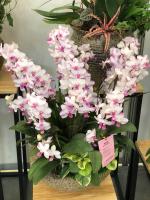How to Care for a Pot Plant
Keeping a pot plant healthy and thriving requires some love and care. With the right attention, your plant can thrive and add beauty to your home or office space. Here are some tips on how to care for a pot plant.
Choose the Right Pot
First things first, choose a pot that's appropriate for your plant's size and growth habits. A small pot is ideal for a plant that won't grow very tall or wide, while larger pots are better for plants with extensive root systems or those that will grow to be quite large. Make sure the pot has adequate drainage to prevent waterlogging.
Provide Adequate Lighting
Most pot plants require adequate lighting to grow and thrive. Typically, plants need bright and direct sunlight, but some can tolerate less direct sunlight. You can place your pot plant in a sunny spot in your home or office, but make sure that it isn't exposed to light for more than eight hours a day, otherwise it can damage the plant.
Water Your Plant
Watering your plant is essential to keep it healthy, but it's vital to strike the right balance. Overwatering can drown the plant, while underwatering can cause it to wither and die. Generally, most plants prefer consistently moist soil, but every plant has different watering needs. Check the soil regularly to see if it's dry, moist, or saturated with water. Water the plant once the top half inch of soil feels dry to the touch. Make sure you use water at room temperature to avoid shocking the plant.
Fertilize Your Plant
Fertilizing your pot plant can help promote healthy growth and keep it thriving. Most plants require feeding every two weeks in the growing season, or whenever you notice the leaves becoming less green or paler. Choose a fertilizer that's suitable for your plant, follow the manufacturer's instructions, and don't overdo it. Too much fertilizer can cause damage, so use it sparingly.
Prune Your Plant
Regular pruning can help maintain the shape of your pot plant and promote healthy growth. Prune any dead, diseased, or damaged branches, stems or leaves as soon as you notice them. If the plant starts to outgrow the pot, remove any leggy or crowded growth.
Pest Control
Pests can easily invade pot plants and cause damage. Check your plant regularly for signs of infestation, like wilting leaves or yellow spots. If you notice pests, like spider mites or aphids, take swift action to remove them. You can use organic methods like neem oil, insecticidal soap or rubbing alcohol to treat affected plants.
In Conclusion
Caring for a pot plant can be a fulfilling and rewarding experience. With these tips, your plant will thrive and add beauty to your home or office space. Remember, every plant has different care requirements, so do your research and pay close attention to your plant's needs.

 how many times do yo...
how many times do yo... how many planted tre...
how many planted tre... how many pine trees ...
how many pine trees ... how many pecan trees...
how many pecan trees... how many plants comp...
how many plants comp... how many plants can ...
how many plants can ... how many plants and ...
how many plants and ... how many pepper plan...
how many pepper plan...
































